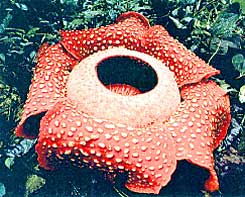By Carol Keisuk Yoon New York Times

Reflexia flower. It was described as having a "permeating smell, more repulsive than that of buffalo carrion in an advanced state of decay." Photo: Portland State University
Direct link to this page: https://www.hayadan.org.il/replesia.htrml
After more than 180 years of wondering, the mystery of the origin of the plant, which produces the largest flower in the world, has been solved. According to researchers, the origin of the unusual Reflexia plant - whose flower diameter can reach about 90 centimeters, and which was described by the Swedish researcher Erik Mjoberg as having a "permeating smell, more repulsive than that of buffalo carrion in an advanced state of decay" - is in a group of delicate plants, Among them is Havalov Hador, Violet and Passionflower.
"It was a complete surprise," says Dr. Todd Berkman, a botanist at Western Michigan University and lead author of the paper, which was published online this month in the journal Proceedings of the National.
"Academy of Sciences "There were those who thought that Rafflesia came from a family of other large plants that emit a bad smell, but no one really knew what to do with this plant."
Dr. John Beaman, a botanist and professor emeritus at Michigan State University, says that in the 20 years he has been studying Reflexia he has been "at a loss" as to its origins. He praised the new study and said that in his opinion "Barkman presented a well-reasoned argument".
Reflexia, which includes 20 different species, is a strange plant in every possible sense. In addition to producing large, smelly flowers, it is also a parasite. Unlike almost any other plant, it has no leaves or green tissue whose purpose is to capture sunlight to produce food in the process of photosynthesis. Instead, in their habitats deep in the forests of Southeast Asia, replantation plants sustain themselves by threading their delicate tissues through the tissues of another plant, a relative of the vine, and stealing all the nutrients they need.
Also, as Dr. Beeman and his son, Dr. Reed Beeman of Yale University discovered in the 80s, the flowers are pollinated by carrion flies looking for nice pieces of rotting flesh. To attract the flies, the repulsion produces the stench.
However, the strangeness of Reflexia, which fascinated biologists, made it very difficult to compare it to other plants and to decipher the question of its origin. It seemed that even modern molecular science could not help solve the riddle. Biologists who examined the Reflexia genome discovered that it has very little data that can be compared to that of other plants. Since Rafflesia does not carry out photosynthesis, it has either lost the genes for photosynthesis or they have been changed so dramatically that comparison with the genes of other plants has become worthless.
Dr. Berkman and his colleagues persisted in the research and found a gene in the mitochondrial DNA of Reflexia, which had not yet undergone a change and which could be compared to other species. The test placed the reflexia in the group known as the Melpigiales series. The diameter of the second largest flower in the Malpigiales series is only about 10 centimeters, a very modest figure compared to the impressive dimensions of the Reflexia.
In addition, the researchers did not discover a close connection between the Rafflesia and the Mysterastema - another species of parasitic plant from the forests of Southeast Asia, which, despite its pollen and although it does not emit a bad smell, was assumed to be one of the relatives of the Rafflesia.
While the Rafflesia flowers have a prominent presence and have therefore been the subject of much research, the plant body, which extends like a mushroom around the tissues of the host plant, is extremely hidden, and therefore much information about the plant remains unknown. Meanwhile, the forests in which the repulsa grows are rapidly being destroyed and the number of plants is rapidly decreasing.
https://www.hayadan.org.il/BuildaGate4/general2/data_card.php?Cat=~~~757510713~~~199&SiteName=hayadan
